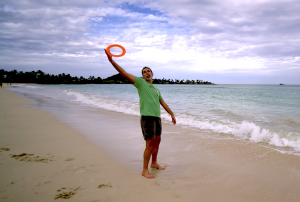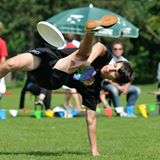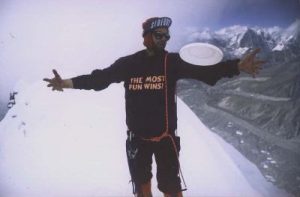Beyond throwing and catching, which are the most fundamental
tools required, initial tooling in my mind has a couple paths.
The outer rim and the center. With the center, you will want
to learn to spin the disc keeping your finger, specifically the
nail, under the center of the disc and in contact with it as
best as you can. This is called a delay. With the outer rim
you want to learn to keep the disc in the air as best you can.
This might include brushing, rolling or kicking and can involve
alot of running around. I will leave the outer rim skills to
one more proficient than I.
When I first learned to delay a disc, I had trouble. I already
knew how to spin a basketball, but had trouble figuring out how
to spin a disc. A spinning basketball, because it has so much
weight away from the center, has a stable center. When you spin
it correctly, the finger “locks” in the center. In fact, I could
spin a basketball on a pencil and hand it to just about anyone
and they could hold it spinning. With a spinning disc, the center
is not stable and the finger wants to drift off center on it’s
own. It takes very small, very quick corrections to maintain
center. It can take some time and repetition to get there.
Further complicating the development of this feel is the gyroscopic
effect intrinsic to spinning objects. When you touch a spinning
disc off center, the disc will “precess”, or turn 90 degrees
from where you touched it. Thus the small corrections discussed
above need to be in the direction of the spin. It will seem
you are always trying to catch up to the correction which wants
to stay 90 degrees ahead of your finger! This results in the
finger seeming to be doing really small circles near the center
of the disc. As you get more proficient, these “circles” and
the corrections get so small that it appears the finger is staying
still in the center of the disc!
Higher level functions such as skids and turnovers will use this
precessive property of discs in a complicated way to achieve
the moves. Skids, or “against the spin” moves work against the
prevailing precession while turnovers are done with the spin
in one direction until the turnover and then with the spin in
the other direction. What complicates it is the need to work
at non-flat angles and switching your brain from one spin’s thinking
to the other.
Paul Kenny






